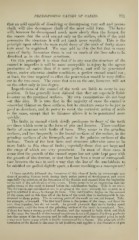Page 761 - My FlipBook
P. 761
PREDISPOSING CAUSES OF CARIES. 771 ;
that an acid capable of dissolving or decomposing very soft and porous
chalk will also decompose chalk of the most solid form. The latter
will, however be decomposed much more slowly than the former, for
the reason that the acid can act only on the surface, while if the acid
permeates the structure it will act much more rapidly. This is the
principle upon which the more rapid decay of the teeth of faulty struc-
ture must be explained. We may add to this the fact that in many
cases of faulty formation there is not so much of the lime salts to be
dissolved as in the denser structures.
On this principle it is clear that if in any case the structure of the
enamel is imperfect it will be more susceptible to injury by the agents
productive of caries than if it were perfect, and will be penetrated
where, under otherwise similar conditions, a perfect enamel would not
at least, the time required to effect the penetration would be very differ-
ent in the two cases. The cause that acts on the one, however, will act
on the other only in less degree.
Imperfections of the enamel of the teeth are liable to occur in any
position. It has generally been claimed that they are especially liable
to occur on the jjroximal surfaces. My own examinations do not bear
out this idea. It is true that in the majority of cases the enamel is
somewhat thinner on these surfaces, but its structure seems to be just as
good as elsewhere, and its power to resist the corrosive action of acids
is the same, except that its thinness allows it to be penetrated more
quickly.
The faults in enamel which chiefly predispose to decay of the teeth
are those which occur in the form of pits and fissures. These combine
faults of structure with faults of form. They occur in the grinding
surfaces, and less frequently in the buccal surfaces of the molars, in the
grinding surfaces of the bicuspids, and in the palatine surfaces of the
incisors. Teeth of the best form and structure otherwise seem to be
most liable to this class of faults ; especially those that are large and
the cusps of which are very prominent. In most of these cases it
seems that the growth of the enamel organ has not quite kept pace with
the growth of the dentine, or that there has been a want of correspond-
ence between the two in such a way that the last of the ameloblasts to
be calcified are pulled slightly apart, a fissure resulting as a consequence.^
' I have carefully followed the formation of this class of faults in microscopic sec-
tions of growing human teeth during their entire period of development, and noted
especially the relations of the formation of the dentine and enamel from the beginning
to the end of the calcification of the crown. There seems to be an impression that the
entire crown of the tooth is formed before the calcification begins. This is an error.
The formation and calcification are in progress at the same moment, but as soon as a
part is calcified it ceases to change its form. This calcification begins on the summit
of the cusps, and at this time all of the form of the tooth that is unchangeable is rep-
resented in those points. Tlie remaining parts of the tooth are not yet formed. Take,
for example, a bicuspid. The first hard tissue is the points of the cusps, and these lie
very close together, but do not touch. As growth proceeds they move farther apart
continuously until the form of the grinding surface of the tooth is completed. Now,
if there has been a strong growth of dentine, and the enamel is built thick and high
on the cusps, the breadth of the enamel-membrane is not sufficient to dip down perfectly
into the centre of the depression, and its cells are separated at the central point in such
a way as to leave a gap which is finally represented by a fissure. The princi])le of the
formation of the fissure is the same in all positions, and applies to the formation of pits


